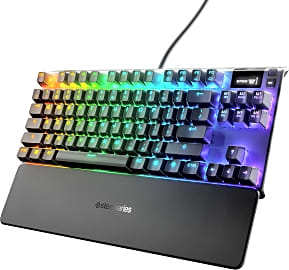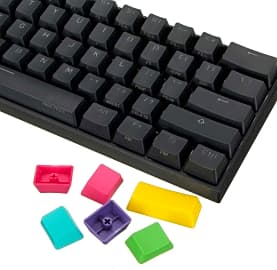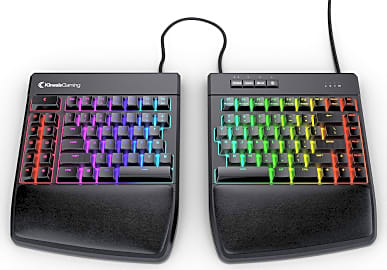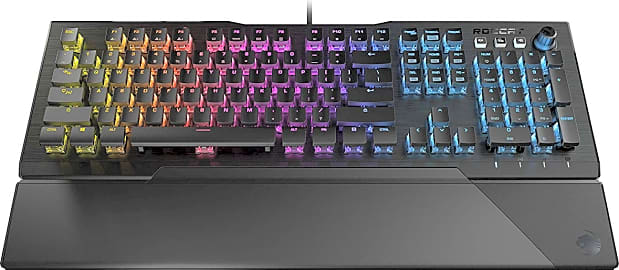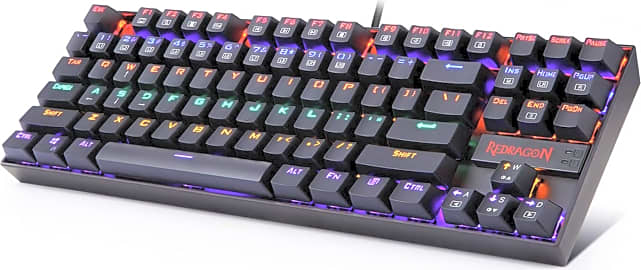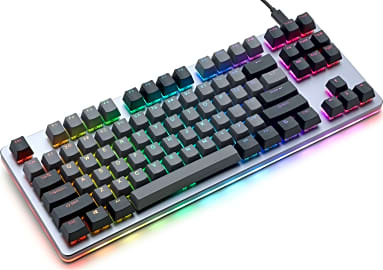The 9 Best Computer Keyboards

This wiki has been updated 38 times since it was first published in May of 2015. If you're going to spend hours on a computer every day, you might as well be as comfortable and efficient as possible. Whether you're writing a novel or on a marathon gaming session, one of these keyboards will see you through to the end with fine ergonomics, useful features, and the perfect switches for your needs. We've ranked them here by comfort, durability, adaptability, and style. When users buy our independently chosen editorial choices, we may earn commissions to help fund the Wiki.
Editor's Notes
March 30, 2021:
Some notable changes this time around were the removal of the Perixx Periduo 606 due to long-term reliability issues, as well as the Logitech MX Keys, which suffered from a few too many inconsistencies to be worth its relatively steep price tag. We also decided to move away from recommending the Corsair K95 Platinum XT, because it's about the same price as the Roccat Vulcan Aimo 121 and SteelSeries Apex but doesn't have quite the same premium finish.
In their place we've added two quality models. The Redragon Kumara K552 has just about the best price-to-performance ratio possible, and is extremely durable, although it has a pretty long key travel. Then there's the Glorious Modular, which doesn't look fancy, but is actually one of the best-made options on the market. In fact, whether you're gaming or typing thousands of words per day, its convenient design allows for easy switch replacement to meet your specific needs.
March 13, 2020:
Some people use their keyboard for fun, some for work, and some for both. If you're in the first camp, the Corsair K95 Platinum XT and Roccat Vulcan Aimo 121 are both worthy of consideration. They're slightly bulky, but they're engineered for quick response time, as well as the ability to hold up under the pressure of intense gaming sessions. They both come with wrist rests, as well, and the fact that they're great for gaming does not in any way diminish how nice they are to type on in general.
If you don't generally play games, but you do type a lot, you should take a look at a good ergonomic keyboard. The Logitech Ergo K860 is one of the most thoughtfully designed such options, with a supremely comfortable wrist rest and a split and flared layout that caters to healthy wrists, elbows, and shoulders. The Perixx Periduo 606 is pretty similar, and in fact comes with adjustable legs that allow for negative incline -- many typists and general computer users don't realize it, but negative tilt is actually even better for joints than the standard direction of incline used by ergonomic keyboards.
Keeping in mind that you can always turn off the backlight of any keyboard, if flashy peripherals are really not your thing, the Logitech MX Keys might be what you want. Not everyone prefers its membrane configuration, but it's not by any means unpleasant, and its connectivity, battery life, and Logitech Flow compatibility are all worthy of praise. Alternately, the Havit 395L is a relatively simple and inexpensive mechanical option that performs surprisingly well for something so inexpensive.
Then there the compact keyboards. Dedicated mechanical keyboard enthusiasts rave about the Anne Pro 2, and for good reason; it's impeccably well made and offers customizable per-key lighting that's great for gamers and programmers alike. And if you can afford it, the Massdrop CTRL is one of the best small form factor keyboards currently made, although it's understandable if you don't want to drop so much cash on a typing device.
We also want to highlight the Kinesis Freestyle Edge. Its split design makes it a great choice for those who aren't satisfied with typical ergonomic models. It also happens to use high-quality mechanical switches and have a programmable backlight, so even hardcore gamers will appreciate it.
What Does The Future Hold For Keyboards?
Your ex's array of proverbial buttons, so easily pressed with the right words, or the right lack of sincerity?
Did you know there are ten different types of keyboards currently being manufactured, and experimented upon in laboratories around the globe?
Despite musicians, gamers, and YouTube-commentators knowing all too well what qualifies as a "keyboard" nowadays, engineers have a surprisingly broader understanding of the term.
That number pad on your microwave? That's a keyboard.
That long-lost TV remote, tucked snugly twixt Aunt Margaret's flabby folds, witnessing first-hand a unique case of necrotizing fasciitis (your search engine is not your friend)? A keyboard.
Your ex's array of proverbial buttons, so easily pressed with the right words, or the right lack of sincerity? Not a keyboard.
Did you also know that most laptop keyboards consist of dozens of miniature toilet plungers called dome switches? Trust me, you don't want to test them all out for yourself. I tried it once on a friend's laptop and he ended up with a butt-load of malware.
What's cool, though, is that keyboards like this one from Alfonso Cuarón's, Children of Men are really not all that far-fetched.
In fact, what we currently call hands-free computing may eventually take Cuarón's vision a few steps further.
Understanding Cherry's Legacy, Not The Fruit Kind
Founded in 1953, Cherry Corporation invented what we still call MX switches in 1984.
Cherry MX switches are the crux of mechanical keyboards. There are four major types: black, brown, blue, and red.
The oldest of the bunch, the blacks, are the stiffest. Boasting the strongest springs, these switches rebound faster than any other switches making it easier to double-tap the keys, if you have any strength left to do so.
Unless you have a ton of cash at your disposal to demand a custom keyboard, you don't have much of a choice.
The browns, introduced in 1994, were designed to make much less noise than the blacks and thus became a much more popular option for people in offices and other public settings.
Invented a mere year apart from one another in 2007 and 2008, the blues and the reds were designed to replace both the black and the brown switches, respectively. The blue being a click-clacking equivalent of the black switch, demanding far less effort on the typist's part, and the red being a lighter-weight version of the brown switch, allowing for much more rapid actuation.
As a result, we tend to see the reds most frequently in mechanical keyboards designed specifically for gaming (remember that first video about the three types of keyboards?) while the blues tend to find more love among typists.
Unfortunately, keyboards are not quesadillas. Unless you have a ton of cash at your disposal to demand a custom keyboard, you don't have much of a choice. You either accept whichever switch the manufacturer personally prefers for specific designs, or you don't. They honestly don't seem to care all that much.
What The QWERTY Are You Talking About?
Inspired by the Situationist Insurrection of May, 1968, during which student protesters lifted cobblestones from the streets of Paris to reveal the beach hidden below, Michel Foucault, a well-known French philosopher, historian, and social critic, delivered the following words: "We are subjected to the production of truth through power and we cannot exercise power except through the production of truth."
The beach itself, a sea of shifting sands incapable of supporting weight the moment you begin to question, why for why and what for what.
Imagine, now, a world where QWERTY constitutes six cobblestones situated comfortably in the middle of a street. Beneath that street, a beach. The beach itself, a sea of shifting sands incapable of supporting weight the moment you begin to question, why for why and what for what.
We know the diagonal offset was due to technological limitations in 1878, back when the first QWERTY typewriter was patented and manufactured to mass appeal.
And we know that diagonal offset has since been questioned to great effect, as we can plainly see by the #1 keyboard by Kinesis, at the top of this page.
What we don't know, if we sift around a bit too much, is why the center row--currently containing only one vowel, A, thereby forcing us to move our fingers all over the place--has never been challenged by a viable alternative.
One might be inclined to say we're used to it, but what about our monitors, our motherboards, our processors, our RAM?
Keep in mind, QWERTY is not an octave on a keyboard. It has no music theory to back it up. Just a bit of trial and error by one guy who died over a century ago and was heavily influenced by the technological limitations of the 19th Century.



